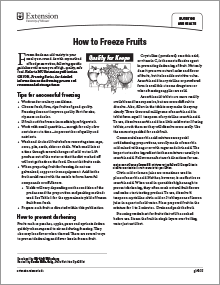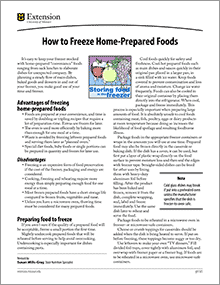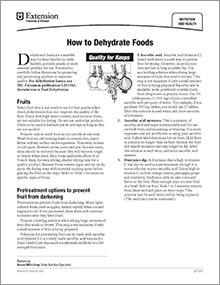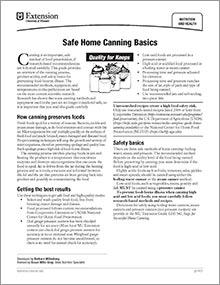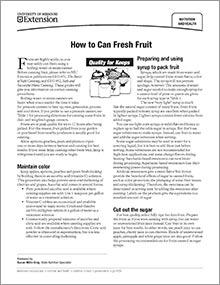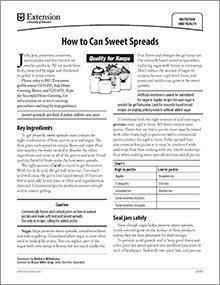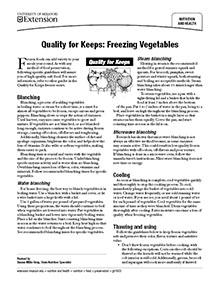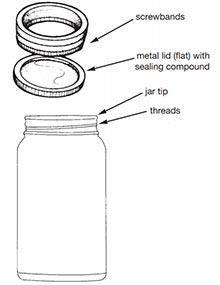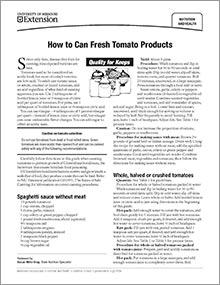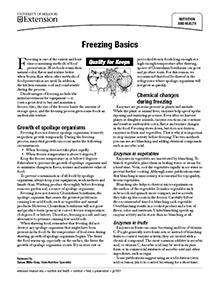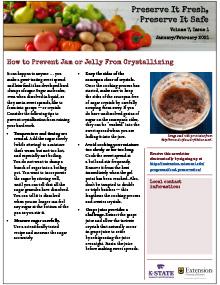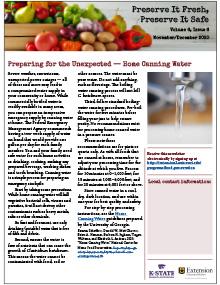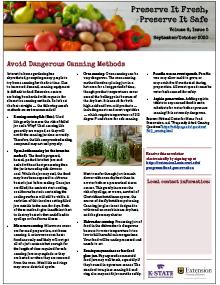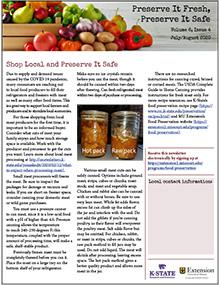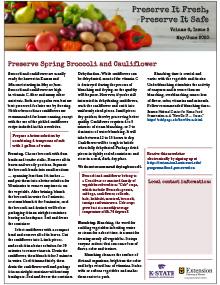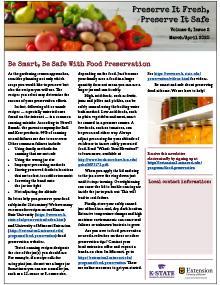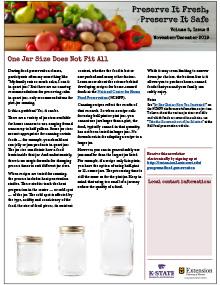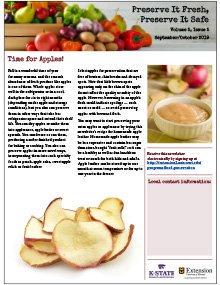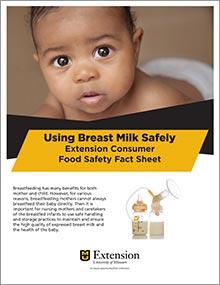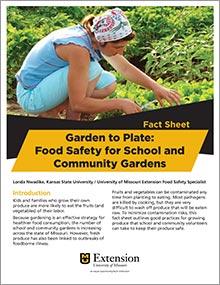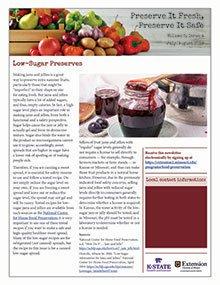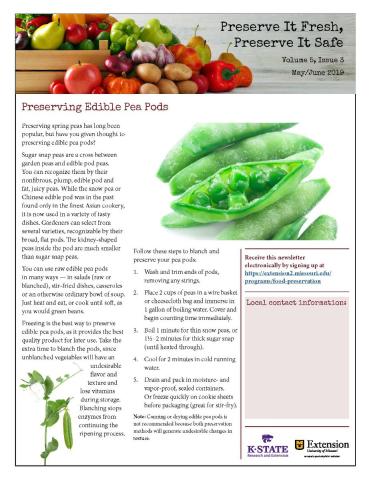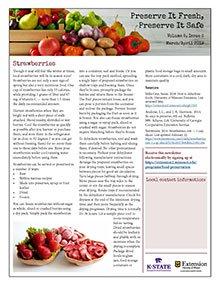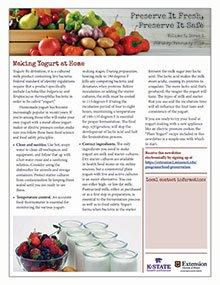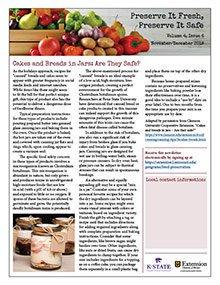The following publications cover topics related to Food Preservation. For a complete list of MU Extension publications, visit the main Publications page.
How to Freeze Fruits
Reviewed
Learn how to freeze fruits effectively, including tips on preparation, preventing darkening, and approximate yields for various fruits.
How to Freeze Home-Prepared Foods
Revised
Learn to safely freeze home-cooked meals, reduce waste, and reheat dishes with ease using proper packaging and storage methods.
How to Dehydrate Foods
Revised
Learn how to dehydrate fruits and vegetables safely with tips on preparation, pretreatment, and storage for longer-lasting, quality results.
Safe Home Canning Basics
Revised
Learn safe home canning techniques to preserve fruits, vegetables, meats, and more. Follow research-based methods to ensure food safety and quality.
How to Can Fresh Fruit
Reviewed
Did you know there's more than one way to can fresh fruit? Learn the options and what they mean for your final color and taste.
How to Can Sweet Spreads
Revised
Learn to safely prepare and preserve homemade jellies, jams, and fruit butters using tested canning techniques and proper ingredient ratios.
How to Freeze Vegetables
Reviewed
From blanching, cooling and freezing to thawing and using, learn how to safely freeze vegetables — asparagus, beans, broccoli, cabbage, cauliflower, celery, corn, herbs, onions, peas, peppers, potatoes, tomatoes and more — in this MU Extension guide.
Steps for Successful Home Canning
Revised
Learn safe, research-based home canning methods for preserving seasonal produce, including proper equipment, processing times, and techniques.
How to Can Fresh Tomato Products
Revised
Learn safe home canning of tomatoes, including acidification, packing methods, and processing times, to prevent botulism and preserve quality.
Freezing Basics
Reviewed
Learn how to freeze food safely, preserve flavor and texture, and avoid common mistakes for better long-term storage.
Preserve It Fresh, Preserve It Safe: 2021, No. 1 (January/February)
New
Prevent jam or jelly crystallization with tips on sugar handling, cooking techniques, and proper storage to ensure smooth, homemade sweet spreads.
Preserve It Fresh, Preserve It Safe: 2020, No. 6 (November/December)
New
Learn how to can water at home to prepare for an emergency and learn the benefits and drawbacks of raw packing and hot packing foods when home-canning in this University of Missouri Extension newsletter.
Preserve It Fresh, Preserve It Safe: 2020, No. 5 (September/October)
New
Home gardening interest has surged and canning tools are scarce. This issue addresses unsafe canning methods.
Preserve It Fresh, Preserve It Safe: 2020, No. 4 (July/August)
New
Learn safe methods for canning meat and fish, including thawing, packing, and pressure canning techniques.
Preserve It Fresh, Preserve It Safe: 2020, No. 3 (May/June)
New
Get tips on freezing, dehydrating and blanching brocolli and cauliflower; a recipe for pickling cauliflower; and a warning about why so-called dry canning is not safe in this University of Missouri Extension newsletter.
Preserve It Fresh, Preserve It Safe: 2020, No. 2 (March/April)
New
Learn safe, tested methods to preserve food at home, avoid common canning errors—like wrong jar size or improper processing—to ensure success.
Using Breast Milk Safely — Extension Consumer Food Safety Fact Sheet
New
Editor’s note
The following abstract describes a publication that is only available as a downloadable PDF.
Garden to Plate: Food Safety for School and Community Gardens — Fact Sheet
New
Editor’s note
The following abstract describes a publication that is only available as a downloadable PDF.
Preserve It Fresh, Preserve It Safe: 2019, No. 4 (July/August)
New
Learn safe methods for making low-sugar jams, jellies, and spreads, plus tips for preserving fruits like white peaches and pineapple.
Preserve It Fresh, Preserve It Safe: 2019, No. 3 (May/June)
New
Discover safe methods for blanching and freezing sugar snap peas to preserve peak flavor, texture, and nutritional quality.
Preserve It Fresh, Preserve It Safe: 2019, No. 2 (March/April)
New
Learn how to choose, store, freeze, and dry strawberries to enjoy their flavor and nutrition beyond the harvest season.
Preserve It Fresh, Preserve It Safe: 2019, No. 1 (January/February)
New
Step-by-step tips for homemade yogurt: sanitize tools, control temperatures, and use just milk plus starter for safe, satisfying results.
Preserve It Fresh, Preserve It Safe: 2018, No. 6 (November/December)
New
Tips for stress-free holiday food-prep and gifting: Gift dry cake and bread mixes layered in jars. Label home canned food gifts for safety. Prepare and freeze foods for dinner ahead of time. Learn more in this University of Missouri Extension newsletter.
